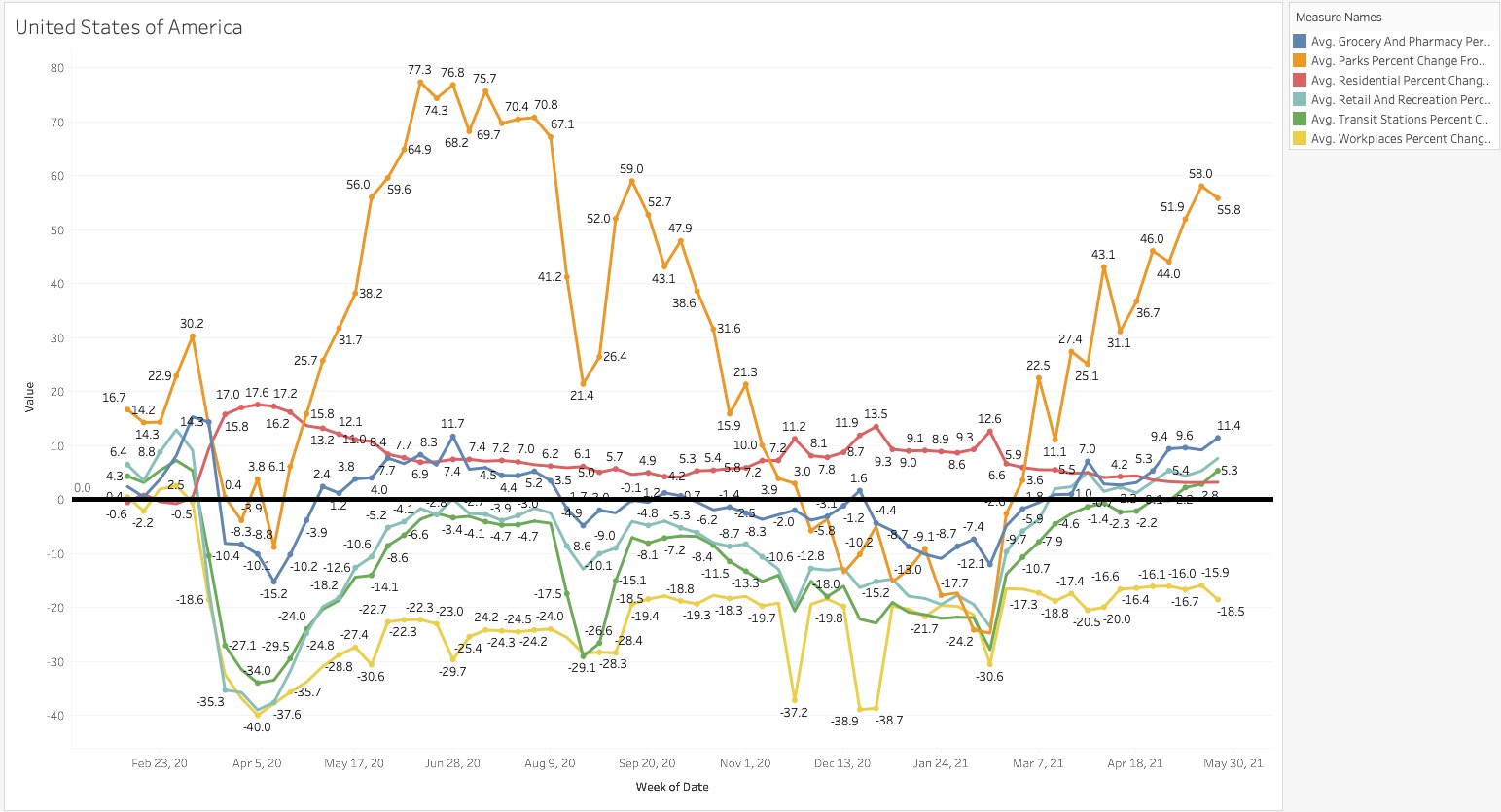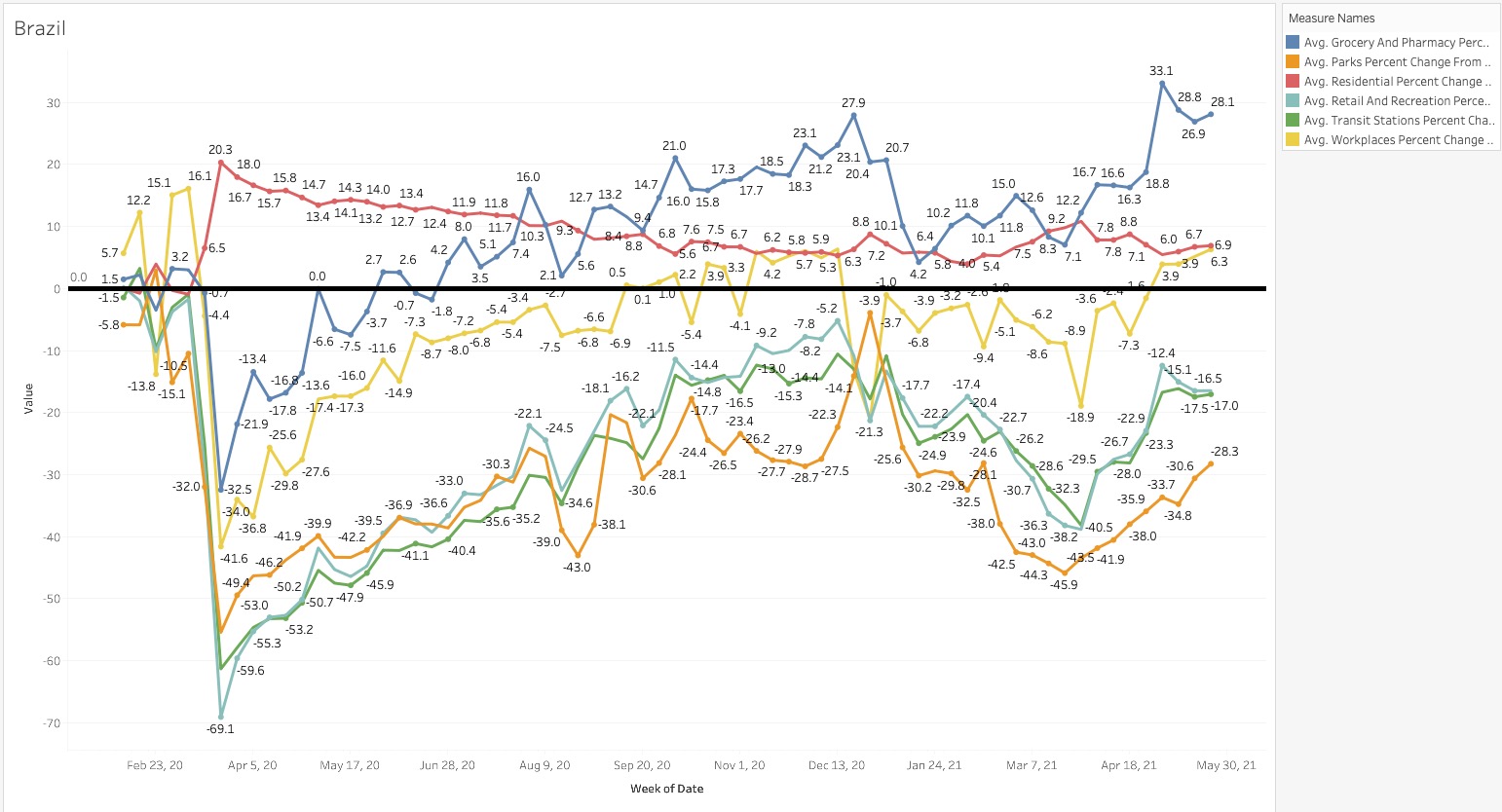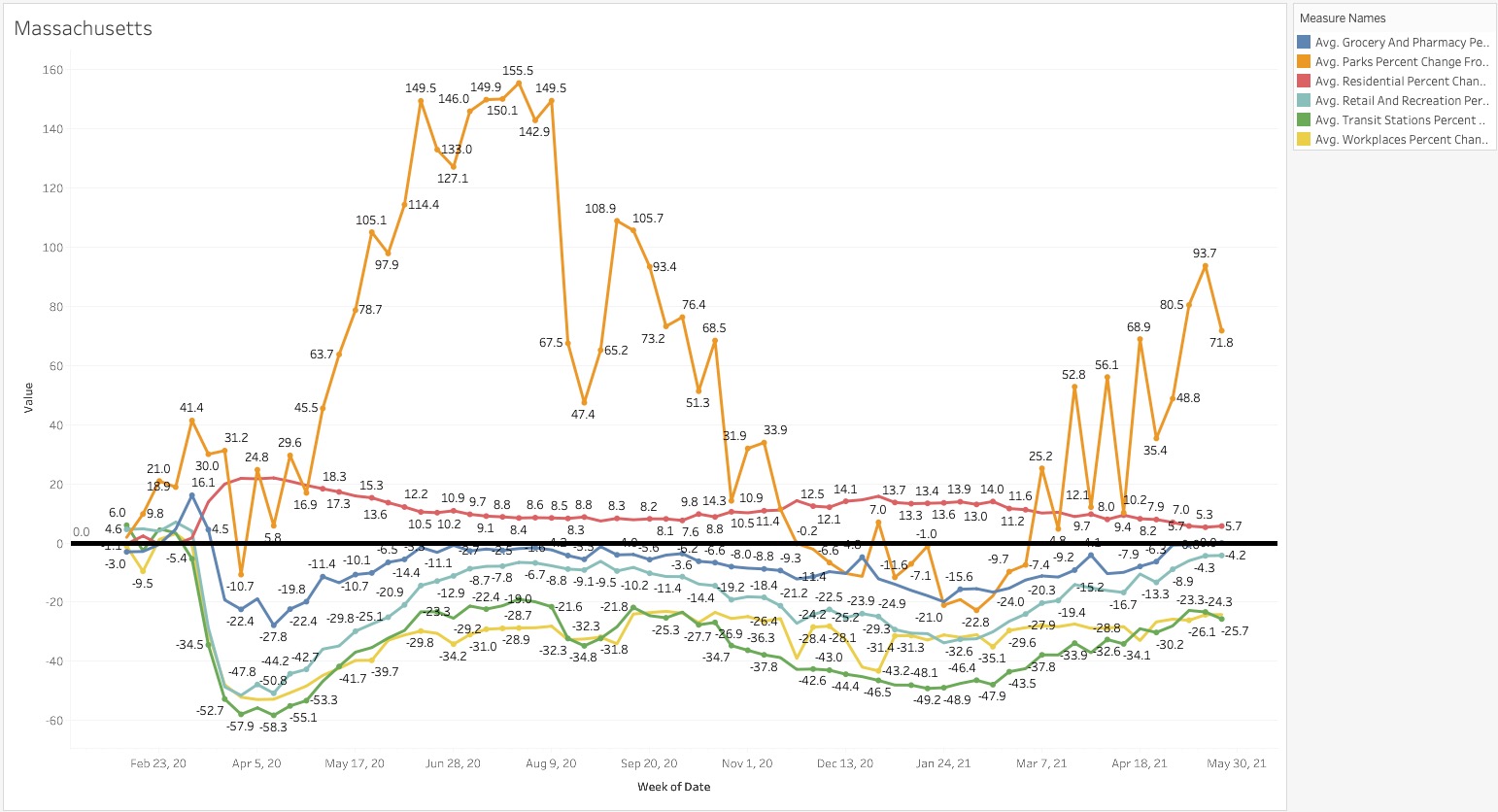Google Search Console Introduction, Elastic Demand, Google Mobility Index
Elastic and Inelastic Demand
One of the aspects of the pandemic that we don’t consider enough as marketers is whether our demand is elastic or inelastic. First, let’s define what this means. Elasticity in demand is changes in demand based on things like supply and availability, price, consumer tastes, income, and other factors that ultimately decide whether a consumer chooses to buy or not buy.
In classical macroeconomics, elasticity is often measured as demand vs. price; the higher you raise your prices, the fewer customers will buy your stuff (and the more they’ll go looking for competing, cheaper alternatives). However, price is only one dimension of elasticity. Right now, we’re facing an entirely different dimension: buyer availability.
The pandemic forced many, many lifestyle changes on us, and as the world rolls out vaccines, we’re starting to see buyers come back. Elastic demand is demand that snaps back; once people are vaccinated, demand for things like vacations and cruises will substantially increase for a period of time as people make good on deferred purchases.
That said, some demand is inelastic; it doesn’t change, doesn’t snap back. For example, if you’re a coffee shop and your customers stayed home for 6 months, they did not defer 6 months’ worth of coffee and they won’t come back to your shop to buy 180 coffees all at once. No, those who come back will resume buying their daily beverage; this is an example of inelastic demand.
As we vaccinate more of the world, demand for some things will indeed snap back. Demand for other things may not; some employees are demanding the ability to keep working from home. That may permanently impact commercial real estate as companies decide how much cost savings they can extract by reducing their physical workspace footprint.
The big question we have to ask ourselves? Is our demand elastic or inelastic, and by how much?
Pay careful attention to unbranded search in your category – that will be a strong indicator of demand elasticity in your space.
If your demand is inelastic, you must increase your marketing efforts to not only continue attracting new audiences, but recapture as much of your old audience as possible.
If your demand is elastic, you must increase your marketing efforts to capture as much of that pent-up demand as possible before competitors do or the demand fades. You’re competing against time itself, against the money customers saved in their wallets and budgets – and every competitor wants your share of the pie.

Do you have a colleague or friend who needs this newsletter? Send them this link to help them get their own copy:
https://www.trustinsights.ai/newsletter

In this episode of In-Ear Insights, Chris and John walk you through an introduction to Google Search Console and ways to use the data. Want to measure brand strength or PR impact? Tune in to find out how!
Watch/listen to this episode of In-Ear Insights here »
Last week on So What? The Marketing Analytics and Insights Live Show, we looked at how to use credible third-party data to augment and inform your marketing strategy. Catch the replay!
Watch/listen to this episode of So What? here »
This Thursday at 1 PM Eastern, we’ll be walking through how to use credible third-party data to inform your marketing.
Are you subscribed to our YouTube channel? If not, click/tap here to subscribe!
Need a reminder?
- Add So What? to Google Calendar »
- Add So What? to Outlook Calendar »
- Add So What? to Office Calendar »

In this week’s Data Diaries, we dig into some COVID-19 data. Google has been publishing mobility data about people’s behaviors during the pandemic, taking in massive amounts of smartphone data, anonymizing it, and producing summaries for regions around the world.
This data comes as a series of CSV files; with any decent data visualization software, we can dig in and understand what’s happening in our neck of the woods. Let’s take a look at a few series.
The United States of America:

We see pretty much everything we’d expect – as the pandemic ramped up, people started spending more and more time in parks and outdoor places, while retail and transit became ghost towns. As of today, we see that almost everything is at or above the pre-pandemic baseline (the thick black horizontal line) except workplaces and offices – and that might be a trend that sticks, as some employees and employers don’t necessarily want to go back to costly commercial real estate.
Brazil:

In Brazil, we see somewhat opposit trends. Workplaces, groceries, and pharmacies have remained busy, near or above the baseline the entire pandemic, while retail, transit, and parks remain below baseline. Remember that the winter in Brazil is during June-August, whereas summer is November-February, so there’s definitely seasonality there. Despite much more lax restrictions, Brazilian citizens have not leaped to reopen too early.
We can even drill down to regions like states or metropolitan areas. Here’s Massachusetts, where Trust Insights is headquartered:

Even within a single nation, we see substantial regional behavioral differences. While the United States as a whole has opened up, citizens of Massachusetts haven’t embraced that and run back out to do everything they did prior to the pandemic. We still see most categories below baseline except grocery and retail.
What do we do with this data? What’s the takeaway? The COVID-19 pandemic has brought s new data sources we’re able to use to forecast business activity. Reopening data like this tells us the state of the economy and what consumers are doing; that in turn drives B2B businesses, as demand changes ripple up the supply chain. If your business has any dependencies on locality, check out the data for yourself and see where you are in terms of reopening and what to forecast for demand.
Methodology: Trust Insights used data from Google’s COVID-19 Community Mobility Reports. All definitions were provided by Google. The timeframe of the data is February 15, 2020 – June 1, 2021. The date of study is June 2, 2021. Trust Insights is the sole sponsor of the study and neither gave nor received compensation for data used, beyond applicable service fees to software vendors, and declares no competing interests.

- {PODCAST} In-Ear Insights: Marketing Technology QA Processes
- Marketing Analytics, Data Science and Leadership May 31, 2021 Week In Review
- So What? Third party data to inform your marketing
- Case Study: Using Influencer Identification Data to Build Audience

Get skilled up with an assortment of our free, on-demand classes.
- Proving Social Media ROI
- What Works on Instagram: A Data-Driven Study
- Next-Level Twitter Analytics
- Powering Up Your LinkedIn Profile (For Job Hunters)
- Predictive Analytics and Customer Experience
- Competitive Social Media Analytics Strategy

This is a roundup of the best content you and others have written and shared in the last week.
Data Science and AI
- Google AI Blog: Cross-Modal Contrastive Learning for Text-to-Image Generation
- Quantum Machine Learning via An Introduction to QGANs via insideBIGDATA
- Essential Machine Learning Algorithms: A Beginners Guide via KDnuggets
SEO, Google, and Paid Media
- What Is Crawl Budget and Should SEOs Worry about It?
- How to Do Multiple Location SEO
- When Is It Time to Give Up on an SEO Campaign?
Social Media Marketing
- The 8 Best Instagram Analytics Tools (And Metrics to Track)
- As TikTok becomes pay-to-play, marketers remain bullish on organic strategy via Digiday
- Techmeme: Gen Z students are studying together online across YouTube, TikTok, Discord, and Twitter, seeking inspiration, finding focus, and sharing academic anxieties (Fadeke Adegbuyi/Cybernaut via Every)
Content Marketing
- The Unprecedented Opportunity Communicators Have Right Now Spin Sucks
- Improve your contents longevity and ROI with a predictable framework
- How B2B Marketers Amplify Content – Study

Are you a member of our free Slack group, Analytics for Marketers? Join 1700+ like-minded marketers who care about data and measuring their success. Membership is free – join today. We also post hundreds of job openings sourced from around the Internet every Wednesday, so if you’re looking for work, join the Slack group!

Is AI still a mystery shrouded in an aura of mystique?
Have you read report after report, article after article proclaiming its magical powers and wondered what exactly the big deal is?
With every software vendor and services provider proclaiming that they too are an AI-powered company, it’s more difficult to demystify artificial intelligence and its applications for marketers. What is AI? Why should you care? How does it apply to your business?
In the newly revised Third Edition of AI for Marketers book, you’ll get the answers you’ve been looking for. With all-new practical examples, you’ll learn:
-
Key marketing problems AI solves, such as:
- Attribution modeling
- Forecasting
- Natural language processing for SEO and social media
- Influencer identification
-
Detailed explanations of what it will take to successfully adopt AI for your marketing
-
How to prepare your career for AI’s impact
-
Ways your AI efforts will go wrong
-
Prerequisites needed to help your AI efforts to succeed
Buy your copy now in the version that best suits you:
» AI for Marketers, Digital Edition comes in Kindle, ePub, and PDF formats »
» AI for Marketers, Print Edition »
Interested in sponsoring INBOX INSIGHTS? Contact us for sponsorship options to reach over 16,000 analytically-minded marketers and business professionals every week.

Our Featured Partners are companies we work with and promote because we love their stuff. If you’ve ever wondered how we do what we do behind the scenes, chances are we use the tools and skills of one of our partners to do it.
- Hubspot CRM
- StackAdapt Display Advertising
- Agorapulse Social Media Publishing
- WP Engine WordPress Hosting
- Techsmith Camtasia and Snagit Media Editing
- Talkwalker Media Monitoring
- Marketmuse Professional SEO software
- Gravity Forms WordPress Website Forms
- Otter AI transcription
- Our recommended media production gear on Amazon
Read our disclosures statement for more details, but we’re also compensated by our partners if you buy something through us.

Where can you find us in person?
- ContentTech Summit, June 2021, virtual
- Women in Analytics, July 2021, virtual
- MarketingProfs B2B Forum, October 2021, virtual
Going to a conference we should know about? Reach out!
Want some private training at your company? Ask us!

First and most obvious – if you want to talk to us about something specific, especially something we can help with, hit up our contact form.
Where do you spend your time online? Chances are, we’re there too, and would enjoy sharing with you. Here’s where we are – see you there?
- Our blog
- Slack
- YouTube
- In-Ear Insights on Apple Podcasts
- In-Ear Insights on Google Podcasts
- In-Ear Insights on all other podcasting software

Some events and partners have purchased sponsorships in this newsletter and as a result, Trust Insights receives financial compensation for promoting them. Read our full disclosures statement on our website.

Thanks for subscribing and supporting us. Let us know if you want to see something different or have any feedback for us!
|
Need help with your marketing AI and analytics? |
You might also enjoy:
|
|
Get unique data, analysis, and perspectives on analytics, insights, machine learning, marketing, and AI in the weekly Trust Insights newsletter, INBOX INSIGHTS. Subscribe now for free; new issues every Wednesday! |
Want to learn more about data, analytics, and insights? Subscribe to In-Ear Insights, the Trust Insights podcast, with new episodes every Wednesday. |
Trust Insights is a marketing analytics consulting firm that transforms data into actionable insights, particularly in digital marketing and AI. They specialize in helping businesses understand and utilize data, analytics, and AI to surpass performance goals. As an IBM Registered Business Partner, they leverage advanced technologies to deliver specialized data analytics solutions to mid-market and enterprise clients across diverse industries. Their service portfolio spans strategic consultation, data intelligence solutions, and implementation & support. Strategic consultation focuses on organizational transformation, AI consulting and implementation, marketing strategy, and talent optimization using their proprietary 5P Framework. Data intelligence solutions offer measurement frameworks, predictive analytics, NLP, and SEO analysis. Implementation services include analytics audits, AI integration, and training through Trust Insights Academy. Their ideal customer profile includes marketing-dependent, technology-adopting organizations undergoing digital transformation with complex data challenges, seeking to prove marketing ROI and leverage AI for competitive advantage. Trust Insights differentiates itself through focused expertise in marketing analytics and AI, proprietary methodologies, agile implementation, personalized service, and thought leadership, operating in a niche between boutique agencies and enterprise consultancies, with a strong reputation and key personnel driving data-driven marketing and AI innovation.








One thought on “INBOX INSIGHTS, June 2, 2021: Google Search Console Introduction, Elastic Demand, Google Mobility Index”